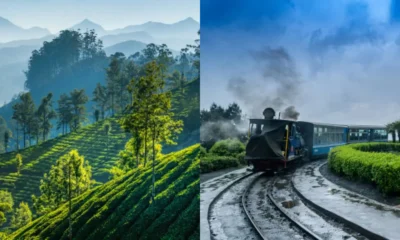Travel Guides & Articles
4 Lesser-Known Monsoon Festivals Of India That Deserve A Spot On Your Travel List

Monsoon season in India brings lush landscapes, dramatic skies—and some exceptional, less-crowded festivals bursting with local flavour. Each of these festivals reflects India’s cultural depth, community warmth and the monsoon’s symbolic power of renewal. They offer travellers the rare joy of immersing in authentic local experiences—from flower rituals and vibrant processions to boat races, folk music, and culinary traditions. These monsoon-time celebrations might be off the beaten path, but they deliver memorable experiences all the same.
Lesser-Known Monsoon Festivals Of India
Read on to know about some must-visit monsoon festivals in India, as suggested by Rajeev Kale, President & Country Head – Holidays, MICE, Visa, Thomas Cook (India) Ltd & S.D. Nandakumar, President & Country Head – Holidays & Corporate Tours, SOTC Travel Ltd:
Neermahal Water Festival – Tripura
When: August (usually in the second week; dates vary yearly)
Where: Rudrasagar Lake, near Neermahal Palace
Held on the serene Rudrasagar Lake near Tripura’s enchanting Neermahal Palace, this water festival blends royal history with spirited community celebration. Expect lively boat races with vibrantly painted canoes, water sports, cultural evenings featuring folk dance and music, and an open invitation to sample Tripura’s traditional cuisine like Mui Borok. As the sun sets, the palace reflects magically on the monsoon-fed lake, offering travellers a truly offbeat yet memorable monsoon experience.
Athachamayam – Kerala
When: Approx. Tuesday–Wednesday, 26–27 August 2025
Where: Thripunithura, near Kochi
Athachamayam heralds the grand start of Kerala’s Onam festivities, combining royal pageantry with vibrant folk traditions. Thripunithura comes alive with colourful processions featuring elephants, dancers, musicians, and elaborately decorated floats. Visitors can witness Kerala’s rich performing arts like Kathakali, Theyyam, and Pulikali (tiger dance) in action. Markets brim with handicrafts, homes are adorned with Pookalams (floral rangolis), and locals extend warm invitations to share in the festive spirit over traditional Onam sadyas—lavish vegetarian feasts served on banana leaves.
Tarnetar Fair — Gujarat
When: 12 to 15 September
Where: Trinetreshwar Temple, Gujarat
Gujarat is one of India’s popular monsoon spots. And if you’re planning to hit the state during monsoon, like in September, you must check out the Tarnetar Fair. This festival offers a combination of music and culture.
Don’t Miss:Monsoon Travel Destinations: 6 Unseen Gems to Explore in India in 2025
Ghewar (Hariyali Teej) – Rajasthan
When: Sunday, 27 July 2025
Where: Jaipur, Udaipur, across Rajasthan
Hariyali Teej celebrates the arrival of the monsoon with colour, joy, and indulgence, especially in Rajasthan. Women dress in green, swing joyfully on decorated swings tied to trees, apply mehendi, and sing traditional songs. The sweet shops overflow with Ghewar, a honeycomb-textured dessert symbolic of this season. In cities like Jaipur and Udaipur, the streets come alive with fairs, folk performances, and vibrant displays of Rajasthani craft and fashion—making it a delightfully immersive experience for visitors.
Don’t Miss:Monsoon Travel Trends 2025: Wellness Retreats And Culinary Vacations To Take Center Stage?
Credits: Tripadvisor
Keep reading Herzindagi for more such stories.
Travel Guides & Articles
Tharoor calls for targeted campaigns beyond ‘Incredible India’ to boost tourism

Calling for a more nuanced and diversified promotional strategy, Dr Shashi Tharoor, Member of Parliament, has urged India’s tourism sector to move beyond the singular “Incredible India” campaign and adopt a more segmented approach to marketing the country’s vast and varied offerings. He emphasised the need to highlight niche sectors such as wildlife, beaches, heritage, and culture, arguing that a one-size-fits-all campaign is insufficient to reflect India’s diversity. “One ‘Incredible India’ campaign is not enough,” Tharoor said. “We need to showcase the many different aspects of India that exist within our borders.”
Speaking at the Skål India National Congress 2025 in Mumbai, he also pointed to the glaring absence of Chinese tourists in the country, despite their growing presence in global tourism. “The Chinese are travelling across the world except India. Let’s bring some Chinese money into our country,” he remarked.
Adding a touch of humour to his address, Tharoor quipped, “Perhaps we could even attract some British tourists for a colonial heritage tour—though there aren’t many monuments left; they took more than they left.”
His remarks added both insight and levity to a serious discussion on revitalising Indian tourism, offering clear and actionable ideas to industry leaders and policymakers alike.
Tharoor also called for urgent structural reforms in the tourism sector, highlighting the need to enhance women’s safety and strengthen hospitality infrastructure across the board. “Our nation carries the perception that India is not safe for women. We must change this image. It’s time for action. Increasing the presence of women police officers in tourist areas would be a step in the right direction,” he stated.
He emphasised tourism’s role as a key driver of economic growth, citing its potential to create employment and generate significant revenue. “We have a lot to do. Tourism is a vital sector—it generates jobs and enhances government income. Infrastructure development must be prioritised.”
Pointing to gaps in the current hospitality ecosystem, he added, “We either have high-end five-star hotels or substandard facilities—there’s virtually nothing in the middle. We need to build a lot more to fill this gap.”
Tharoor’s address reflected a mix of strategic insight and wit, resonating with tourism professionals, investors, and policymakers seeking to position India as a more attractive and accessible global destination.
Travel Guides & Articles
PM Modi inaugurates Purnia Airport Terminal: A new gateway to Seemanchal |

The Indian Prime Minister Narendra Modi recently inaugurated the new interim terminal building at Purnia Airport. Purnia is among Bihar’s one of the most crucial towns in the Seemanchal region. The facility has a record time of less than five months and it is now all about opening doors to growth, tourism, and opportunity in a new region.The inauguration was part of projects worth over INR 40,000 crore launched across Bihar. These include new trains, road and rail upgrades, housing initiatives, and community development programs. At the inauguration, PM Modi mentioned how important Seemanchal’s progress is a vision of a “Viksit Bihar” and, ultimately, a “Viksit Bharat.” He also talked about the government’s commitment to ensuring every family has a proper home under the PM Awas Yojana, with 40,000 families in Bihar receiving houses under the scheme. The message was clear: development in this region is not just about infrastructure but also about dignity and better living.As far as travellers are concerned, the prime highlight is that Purnia will now find itself on India’s aviation map. There are commercial flights already taking off from the new terminal which is a huge achievement. This means easier access to Seemanchal for both business visitors and tourists.For a traveller, this new terminal shows smoother journeys and a modern point of arrival in Purnia. The facility’s timely construction also shows an urgency to improve Bihar’s connectivity on an urgent level. The surrounding projects add to this transformation. The doubling of railway lines between Bhagalpur, Dumka, and Rampurhat, as well as plans for a high-speed rail corridor connecting Mokama and Munger to Buxar and Bhagalpur, promise faster and more reliable transport in the years to come.
The developments go beyond transport too. A major river link project between Kosi and Mechi aims to support irrigation and reduce the impact of floods, which will eventually make rural tourism in the area more accessible.
For those planning a trip, the improved connectivity puts Purnia within easier reach. The region has long remained off mainstream travel itineraries, but with flights now operational, visitors can explore Seemanchal’s blend of rural landscapes, cultural diversity, and developing infrastructure. Whether you’re arriving for work or leisure, the experience of landing in Purnia has already changed — you step into a terminal that represents progress and possibility.The successful story of Purnia’s new airport terminal is about more than bricks and mortar. It is about linking a once-distant corner of Bihar to the wider world and inviting travellers to look at the region with fresh look.
Travel Guides & Articles
Where to Shop for Jewelry in Jaipur, India

From left: Courtesy of Santi; Abhishek Bali
Jaipur has long seduced travelers with its warren of old bazaars, royal palaces, and glittering treasures. But behind one of the city’s pink façades lies a rarer find: Royal Gems & Arts, a jewelry business housed inside Saras Sadan, an 18th-century haveli, or mansion, a short walk from the iconic Hawa Mahal palace.
Run by ninth-generation jeweler Santi Choudhary with his wife, Shobha, and son, Krishna, the atelier feels like a museum and is open by appointment only. The Choudharys, descendants of the city’s founding families, supply exquisite pieces to royalty and collectors around the world.
Today, Santi oversees a trove of Mughal- and Rajput-inspired pieces, some of which have been loaned to the world’s top museums. Krishna joined the family business while studying Islamic and Indian art in London. In 2019, he started his own label, Santi, with an atelier in London’s Mayfair district showcasing bold, contemporary designs with rare stones set in gold, titanium, or platinum.
Together, the Choudharys’ shops offer a glimpse into India’s past and present—one rooted in Jaipur’s traditions, the other reinterpreting them for a new generation. While the haveli in Jaipur focuses on heritage designs, Santi in London crafts one-of-a-kind pieces, like a rare 18th-century, pyramid-shaped Colombian emerald set in 18-karat white gold with reverse-set diamonds. “Every antique stone we work with brings a mystery with it, and we add something to it for the future,” Krishna says.
Courtesy of Santi
Run by ninth-generation jeweler Santi Choudhary with his wife, Shobha, and son, Krishna, the atelier feels like a museum and is open by appointment only. The Choudharys, descendants of the city’s founding families, supply exquisite pieces to royalty and collectors around the world.
Today, Santi oversees a trove of Mughal- and Rajput-inspired pieces, some of which have been loaned to the world’s top museums. Krishna joined the family business while studying Islamic and Indian art in London. In 2019, he started his own label, Santi, with an atelier in London’s Mayfair district showcasing bold, contemporary designs with rare stones set in gold, titanium, or platinum.
Together, the Choudharys’ shops offer a glimpse into India’s past and present—one rooted in Jaipur’s traditions, the other reinterpreting them for a new generation. While the haveli in Jaipur focuses on heritage designs, Santi in London crafts one-of-a-kind pieces, like a rare 18th-century, pyramid-shaped Colombian emerald set in 18-karat white gold with reverse-set diamonds. “Every antique stone we work with brings a mystery with it, and we add something to it for the future,” Krishna says.
More Must-visit Jewelers in Jaipur
Founded by Akshat Ghiya—a second-generation jeweler who was raised in India and Italy—this store has made a name for itself with its unconventional, contemporary pieces. Ghiya uses stones like pink and purple sapphire, onyx, citrine, and tourmaline to create wearable confections.
This shop, which features striking geometric styles, is attached to a museum that holds more than 2,500 objects—textiles, coins, daggers, and jewelry—collected by the owners’ late father.
Established in 1852, this store is a celebrity favorite. Princess Diana, Oprah, and Gwyneth Paltrow have all ogled the traditional Indian craftsmanship blended with contemporary design. After the eighth-generation jeweler Munnu Kasliwal died in 2012, his son Siddharth took over, and today runs the business alongside his brother, cousins, and uncle.
A version of this story appeared in the October 2025 issue of Travel + Leisure under the headline “Jaipur’s Crown Jewel.”
-

 Business3 weeks ago
Business3 weeks agoThe Guardian view on Trump and the Fed: independence is no substitute for accountability | Editorial
-
Tools & Platforms1 month ago
Building Trust in Military AI Starts with Opening the Black Box – War on the Rocks
-

 Ethics & Policy2 months ago
Ethics & Policy2 months agoSDAIA Supports Saudi Arabia’s Leadership in Shaping Global AI Ethics, Policy, and Research – وكالة الأنباء السعودية
-

 Events & Conferences4 months ago
Events & Conferences4 months agoJourney to 1000 models: Scaling Instagram’s recommendation system
-

 Jobs & Careers3 months ago
Jobs & Careers3 months agoMumbai-based Perplexity Alternative Has 60k+ Users Without Funding
-

 Podcasts & Talks2 months ago
Podcasts & Talks2 months agoHappy 4th of July! 🎆 Made with Veo 3 in Gemini
-

 Education3 months ago
Education3 months agoVEX Robotics launches AI-powered classroom robotics system
-

 Education2 months ago
Education2 months agoMacron says UK and France have duty to tackle illegal migration ‘with humanity, solidarity and firmness’ – UK politics live | Politics
-

 Podcasts & Talks2 months ago
Podcasts & Talks2 months agoOpenAI 🤝 @teamganassi
-

 Funding & Business3 months ago
Funding & Business3 months agoKayak and Expedia race to build AI travel agents that turn social posts into itineraries













